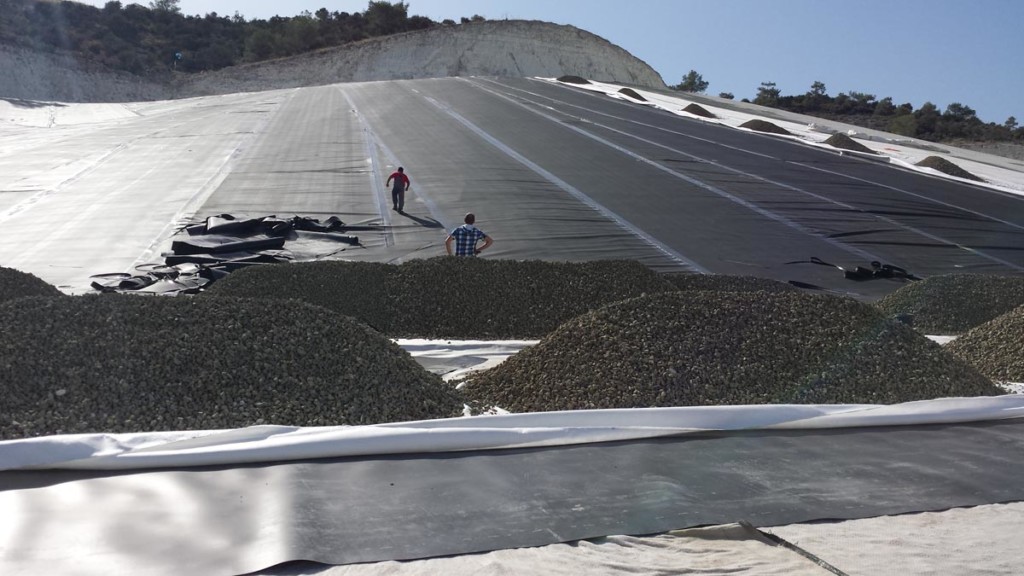The waste management plant at Pentakomo is a flawed design and is not serving its purpose
By Efi Xanthou
These past weeks a new waste fire has been a bitter reminder of the dangerous consequences of the lack of waste management across the whole island. A fire in the Koutsoventis area on the Pentadaktylos mountain range burned for days, spreading toxic fumes and particles across the Mesaoria plain, infecting all areas affected without distinction between the north and south of the Green Line. In addition to the fire being visible across the plain, we could also smell the burning particles riding on the wind.
Turkish Cypriot media outlets reported that the EU-constructed integrated waste management facilities had not been inspected in at least 10 years. Furthermore, the facility had obviously not been functioning according to its specs, since its landfills filled up in six years instead of 10 as originally projected, and the recycling and composting sections were never constructed. Yeni Duzen reported that according to analysis made on October 3, air particles in Nicosia reached 149 mg/m³ while previous analysis registered 32-80 mg/m³. Normal ratings are around 50 mg/m³.
Only a few months ago similar waste fires erupted in the Limassol district, spreading the same dangerous airborne chemicals, creating an uproar across the island. Only in this instance our government insisted that people should not be afraid because no increase in air particles was detected in their aftermath.
We need to start taking waste management much more seriously and realise the perilous danger we all face if something is not done immediately. Waste needs to be separated at the source, if we want to avoid these kinds of toxic fires. There is no other viable way. Organic materials need to be collected separately and be treated in facilities that will harvest the methane produced, in order to keep it from being released into the atmosphere and aggravate the current climate crisis. It will also provide a renewable source of energy and precious compost to help our island stave off the desertification process that is slowly but steadily creeping up on us. Buried waste remains a volatile problem, since methane build-up continues for decades.
Recyclable materials need to be separated not only to reduce the amount of waste that ends up in the very expensive waste treatment facilities, but also to preserve precious materials and stave the need for more oil drilling and mining and quarrying. Whether it is your plastic bottle, or a tin can, or the building materials left over from a construction site, it makes both fiscal and environmental sense to reutilise it rather than create things all over again using extracted raw materials.
Waste separation will also mean that a bare minimum of harmful waste finds itself buried in waste dumps, the ticking time bombs in our rural areas and seas… Batteries, paint materials, toxic chemicals and metals all seem to end up in our dumpsters, and thus are buried with the materials that the waste management facilities cannot separate and do not burn for energy. Do people realise that, without the proper treatment, these harmful materials end up in our food chain and pollute our air, water, earth and bodies? I don’t think most people do.
Only a few weeks ago the House of Representatives environment committee heard evidence on why the Pentakomo Organisation for Integrated Waste Management Facilities (OEDA) had to deal with a waste fire again. The fascinating evidence of how the problems seem to derive both from the flawed design of the facility in conjunction with the huge quantity of fluids and heavy metals that are delivered to the facility through the waste submitted for management, just seems to have passed over our heads.
How is it possible that our glorious government created a waste management system that was not up to par and definitely created more problems than it solved? How can the responsible authorities have decided not to allow the creation of an energy production addendum to the existing, government owned facility at the OEDA plants in Pentakomo and Koshii, and instead prefer for toxic sludge to just be buried? Do they not realise that the methane inevitably produced is a climate pollutant? That fires will definitely erupt at regular intervals, dispersing pollutants all across the island and our seas? That by not utilising the energy production capacity of these facilities they are not only contributing to the destruction of our environment but also wasting tax payers’ money?
What I find most disturbing though is the silence of all the government departments involved when data concerning the huge lead and other toxic and heavy metal waste content was presented to the committee. Even though the company running the government owned facility has been regularly sending reports of its chemical analysis of the waste they receive and they all seem to understand how dangerous this is, nobody offered any solution or mentioned efforts to investigate further.
I know that most readers will not be surprised to discover that once again our government’s infrastructure is failing abysmally. But I hope that it will also be understood that, unless something changes really fast, the consequences of our inaction will be felt intensely before the climate crisis, extreme weather changes our lifestyle dramatically. Let’s hope the right decisions are made by the next government and we see radical changes in waste management sooner rather than later.
Efi Xanthou is a political scientist and the Coordinator of the Interior Committee for the Cyprus Greens-Citizens Cooperation, [email protected]








Click here to change your cookie preferences